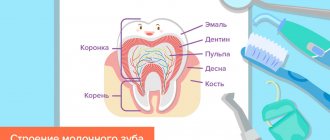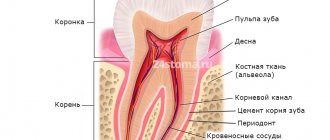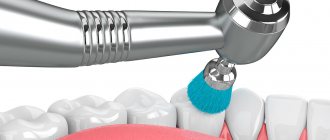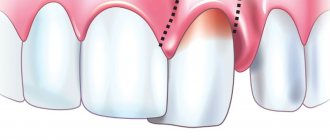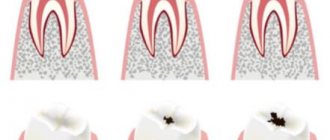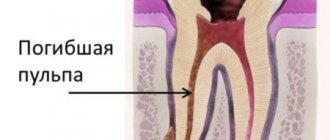Modern dental treatment
Dental treatment of teeth is a set of measures aimed at eliminating the inflammatory process and restoring chewing functions. The most common disease is, of course, caries and its complications. The timing of dental treatment directly depends on the stage of development of the disease. Thus, installing a dental crown or implanting several teeth will take different times, depending on the number of specialist appointments. It is worth noting that regular preventive examinations allow you to notice pathologies at an early stage, allowing for dental treatment without extraction and significantly simplifying it.
If a patient comes to the clinic with acute pain, the task becomes much more complicated. Therefore, every dentist will tell you that the best dental treatment is prevention.
Photos before and after dental treatment
Photos Before and After treatment of chewing teeth.
Photos Before and After treatment of front teeth.
In what cases does wisdom tooth treatment make no sense and must be removed?
- If the dentist has diagnosed “deep caries of the wisdom tooth,” it makes no sense to treat the disease at this stage. In this case, the tooth is simply removed.
- Figure eights affected by caries are removed if they are incorrectly located in the row of the masticatory-maxillary system.
- Extraction (removal) is carried out for chronic recurrent pericoronitis - if the patient regularly has inflamed gums around the eighth tooth.
- The figure eight should be removed if it injures the soft tissues of the inside of the cheeks. This happens when wisdom teeth are incorrectly positioned.
- Treatment of eighth teeth is not carried out if the patient cannot fully open his mouth or there are other obstacles to the procedure.
- Caries will not be treated if the third molars violate the position of the dentition and cause crowding of the canines and incisors. In such situations, the doctor often removes the figure eights and then performs orthodontic correction of the displaced teeth.
- Basal caries and cervical caries of wisdom teeth are also indications for removal in most cases.
Endodontic dental treatment
What is endodontic dental treatment? This is a procedure aimed at treating root canals, usually using a microscope. If you ignore the symptoms of caries for a long time, pulpitis, periodontitis and other complications develop. Endodontic treatment of teeth under a microscope will help eliminate acute pain and relieve inflammation. The help of an endodontist is indispensable when there is a suspicion of a dental cyst or granuloma. Often, after canal treatment, complications arise due to poor quality treatment or stuck pieces of broken instruments. In such difficult cases, they also resort to endodontic treatment of the tooth canal under a microscope.
Causes of tooth mobility
The roots of the teeth are located in the sockets (alveoli), they are firmly connected by the periodontium - a layer of connective tissue, collagen fibers, nerves and blood vessels. It is the periodontium that provides the necessary shock absorption of the dentition, allowing units to move in different planes, dampening chewing pressure. Periodontium is part of the periodontal tissues, such as gums, ligaments, cement, and bone surrounding the roots. If the connections between the alveolus, periodontium and tooth root are disrupted, the dental units begin to move beyond normal limits. The reasons for these changes are:
- inflammation and destructive changes in the periodontium (periodontitis, periodontal disease, periodontitis);
- dental diseases (flux, cyst, etc.);
- chronic systemic diseases (osteoporosis, diabetes mellitus, thyroid dysfunction and other diseases accompanied by metabolic, circulatory, and tissue regeneration disorders);
- malocclusion, uneven pressure on one tooth or group of elements (occlusal trauma);
- bruxism;
- jaw injury (bruise, fracture);
- prosthetics errors (incorrectly installed prostheses, implants);
- damage from solid food;
- large interdental spaces (teeth begin to shift towards the empty space);
- age-related changes (puberty, menopause, pregnancy and lactation, old age);
- bad habits;
- long-term use of certain medications.
Natural mobility associated with age occurs exclusively in children, when baby teeth are replaced by permanent teeth. If a molar tooth in an adult is loose, we are talking about pathology. The cause may be improper redistribution of chewing loads, disease, and not necessarily dental disease. Increased mobility may occur during orthodontic treatment. To eliminate it and stabilize the correction result, after removing braces or aligners, retention devices (retainers) are used.
Treatment without drilling
Dental treatment without drilling involves the use of minimally invasive procedures. Some of them have been mentioned above. In particular, lasers are actively used to eliminate caries. This type of dental treatment is performed for adults and children. Among the main advantages is a reduced risk of any infection, since contact of equipment with organs and tissues of the oral cavity is eliminated.
Also, dental treatment without a drill can be performed using the chemical-mechanical method. A special preparation is applied to the area of the tooth affected by caries. It contains sodium hypochlorite and amino acids. Next, the specialist treats the affected area using special tools. Since only dead tissue is removed, the filling occupies a much smaller area, and it is also possible to preserve healthy areas as much as possible.
Another interesting technique was developed by German specialists. It is based on the bactericidal properties of ozone and is often used in pediatric dentistry. The gas used to treat teeth completely destroys microorganisms that cause caries.
The latest non-invasive methods
Before dental treatment, a specialist determines the degree of destruction of enamel, hard tooth tissue and dentin. In advanced cases, a granuloma forms around the root, which may subsequently increase in size. Modern methods of dental treatment make it possible to successfully combat the first signs of caries without the use of a drill. Among them:
- laser dental treatment;
- application of chemical-mechanical techniques;
- fluoridation – treatment of teeth with calcium;
- application of the air-kinetic method;
- ozone therapy.
Treatment of a tooth under a crown
After some time has passed after the installation of the prosthesis, subsidence of the gums and exposure of the neck of the tooth are often observed. All this contributes to the development of caries, and therefore pulpitis, periodontitis and other unpleasant diseases can appear even when the tooth is covered with a crown. Only a specialist can identify the problem and treat the tooth under the crown. If a disease is detected, the structure may need to be removed.
It is also the cause of problems - errors in the manufacture of the prosthesis: if the crown does not fit tightly around the neck of the tooth, bacteria can get under it. The specialist immediately removes such structures and carries out dental treatment. The crowns will subsequently be replaced, which will preserve the teeth and prevent the development of more serious diseases.
A wisdom tooth affected by caries - treat or remove?
According to statistics, when affected by caries, in approximately 20% of cases, the wisdom tooth can be treated, in 80% it can be removed immediately. The question of treating or removing figure eights is decided by the dentist, taking into account the individual characteristics of a particular patient.
In what cases can experienced dentists treat caries of third molars:
- If the tooth is in satisfactory condition, the carious lesion is superficial or in the stain stage and there are no obstacles to successful treatment.
- It is very desirable to treat wisdom tooth caries if for some reason the patient has had his sixth or seventh teeth removed and the eights bear a large chewing load.
- Treatment of a wisdom tooth affected by caries is also necessary if the figure eights act as a support for orthopedic structures - bridges, crowns.
- Treatment is acceptable if there is no gingival “hood” hanging over the dental crown.
- It is advisable to preserve the tooth even if the opposite jaw also has a figure eight.
Anesthesia
Conventional local anesthesia is performed very often today. Patients with increased sensitivity of soft tissues and children can first be given topical anesthesia. Also in dentistry, painkillers are used for dental treatment. The type of drug and its dosage are selected individually - it all depends on both the patient’s health condition and the clinical situation. For example, pediatric dentists often treat teeth with nitrogen. Laughing gas causes a feeling of mild euphoria and is not hazardous to health. The patient relaxes, and the doctor can calmly perform all the necessary manipulations. But general anesthesia in dentistry is used only in the most extreme cases.
Anesthesia after dental treatment can last up to 3 – 4 hours. Everything here is very individual and depends on how much anesthetic was used.
Features of treatment of anterior teeth
Treatment of anterior teeth is associated with some difficulties. A characteristic feature of the incisors is their smaller size compared to other teeth. The work that a dentist has to do is truly jewelry. Only an experienced specialist can achieve a high degree of aesthetics.
In the process of treating and restoring the shape of a diseased tooth, a filling can be performed using light-curing polymer materials or veneers. Their shade is selected taking into account the color of the enamel of the patient’s healthy teeth.
The last resort is the installation of crowns. This method is justified only if the tooth is severely damaged. Treatment of lower teeth in the frontal zone is performed using similar methods and techniques.
Reason to see a doctor: symptoms that cannot be ignored
If a tooth hurts, treatment should never be delayed. Any delay is fraught with serious problems not only for the oral cavity, but also for the whole body. The sooner the source of infection is identified, the easier and faster dental treatment can be performed in the clinic. Symptoms that indicate serious problems:
- acute throbbing pain in the tooth;
- significant increase in sensitivity;
- bad breath during regular hygiene;
- bleeding and swelling of the gums;
- tooth mobility;
- difficulty opening the mouth;
- the appearance of a defect on a tooth, an area with uneven edges and pigmentation.
How are teeth arranged in teenagers?
A newly erupted and grown tooth needs several years to fully form: its roots are not yet narrow and long enough, and its walls are much thinner. This leads to the fact that the tooth is able to withstand a significantly lower degree of load than at an older age.
Pulp
(nerve) at this age is larger in size, while hard tissues - enamel and dentin - on the contrary, are more permeable, thin, and slightly mineralized. This means that teeth are more fragile and more susceptible to caries. Acids actively act on thin enamel and destroy it - carious processes become more active. The pulp is located close, which increases the risk of inflammation of the neurovascular bundle of the tooth (pulpitis). Treatment of an inflamed nerve is complicated by the fact that it is necessary not only to remove the inflamed tissue, but also to try not to damage the growth area of the tooth root. Otherwise, the root will not be able to grow, the tooth will remain unformed, and its “life” will decrease.
Fissures
(grooves on the chewing surfaces of teeth) at this age are deeper, they often have hidden cavities where bacterial plaque accumulates, which also leads to the rapid development of caries.
Teenagers under 18 years old should not have implants
. Therefore, tooth extraction should be a last resort when no other treatment is possible. Losing a tooth leads to displacement, malocclusion, deformation of the facial bones, and the appearance of gaps. In adolescents, these processes occur especially quickly. In addition, after a tooth is removed, the amount of bone tissue in its place decreases, so it will have to be restored before implantation.
Stages of dental treatment
Despite the fact that modern methods involve virtually painless dental treatment, fillings and other procedures, many patients appear in the doctor’s office with acute pain and a whole “bouquet” of oral diseases. Treatment usually includes the following steps:
Diagnostics
A specialist examines the oral cavity, identifies problems and draws up a treatment plan. Additional examinations may be ordered. At the same stage, the doctor conducting the consultation discusses the cost of services with the patient and selects the most convenient time for an appointment.
Professional oral hygiene
It is advisable to begin dental treatment only after their surface is cleaned of hard and soft deposits.
Treatment
The process of treating caries involves removing the affected tissue. The procedure is performed using local anesthesia, and the treated area is isolated from the rest of the mouth. Rubber dam or cotton swabs can be used for these purposes.
Seals
Filling is carried out after cleaning the carious cavity. The final procedure is grinding the filling - this is necessary to eliminate the occurrence of discomfort during the process of chewing food.
Why does a tooth hurt after treatment and what to do in this case?
Aching pain after treatment occurs quite often. However, its causes may be different, which means that the doctor’s actions to eliminate it are required different. Let's look at the most popular:
- Very often, after treatment, the tooth reacts to mechanical stress when chewing food. As a rule, minor pain appears after treatment of deep caries. This is due to the fact that the filling puts pressure on the pulp. Over time, the pain will pass.
- It is not uncommon for a tooth to ache after treatment and due to an individual reaction to the doctor’s intervention. The pain may persist for several days.
- Acute pain after dental treatment cannot be ignored. You must immediately contact a specialist. Unpleasant pain may indicate that there is inflammation after dental treatment.
- If you are sensitive to irritants such as hot and cold drinks, sweet or sour foods, then there is a high probability that the overhanging edge of the filling will injure the periodontal tissue in the gum area. This phenomenon leads to tissue inflammation and exposure of the tooth root, which is extremely sensitive to any irritants. Therefore, be sure to contact the dental clinic if your tooth aches after recent manipulations. The treatment was most likely carried out poorly.
Pros and cons of removal tactics for caries of the lower or upper eights
Advantages of the extraction (removal) method:
- it is possible to completely eliminate the infectious focus, prevent the spread of the inflammatory process to adjacent teeth and nearby tissues;
- eliminates the risk of crowded teeth and the need for orthodontic correction;
- the risk of recurrent caries is eliminated;
- removal of the third molar allows you to radically solve the issue of pain in the area of this tooth.
The negative aspects of removing wisdom teeth include the risk of postoperative complications, as well as the inability to install a support for bridges or crowns on the figure eights, if necessary.
How much does dental treatment cost in Moscow?
Taking into account the fact that therapy involves an integrated approach, the total cost of dental services will consist of the costs of individual procedures. Approximate prices for dental treatment in Moscow are presented in the table below.
| Type of service | Price |
| Specialist consultation | from 500 rubles, but most often it is free |
| Professional hygiene of the entire oral cavity | from 3,000 rubles |
| Treatment of pulpitis (depending on the number of channels) | from 4,000 rubles |
| Filling using light-curing polymer material | from 3,000 rubles |
| Aesthetic restoration of anterior teeth | from 5,000 rubles |
